How to Feed & Maintain your Sourdough Starter
You’ve done it! You’ve created a living batter filled with wild yeast. Now let’s see how to feed & maintain your sourdough starter.
If you haven’t made your starter yet, visit this post to see how to make a sourdough starter from scratch.
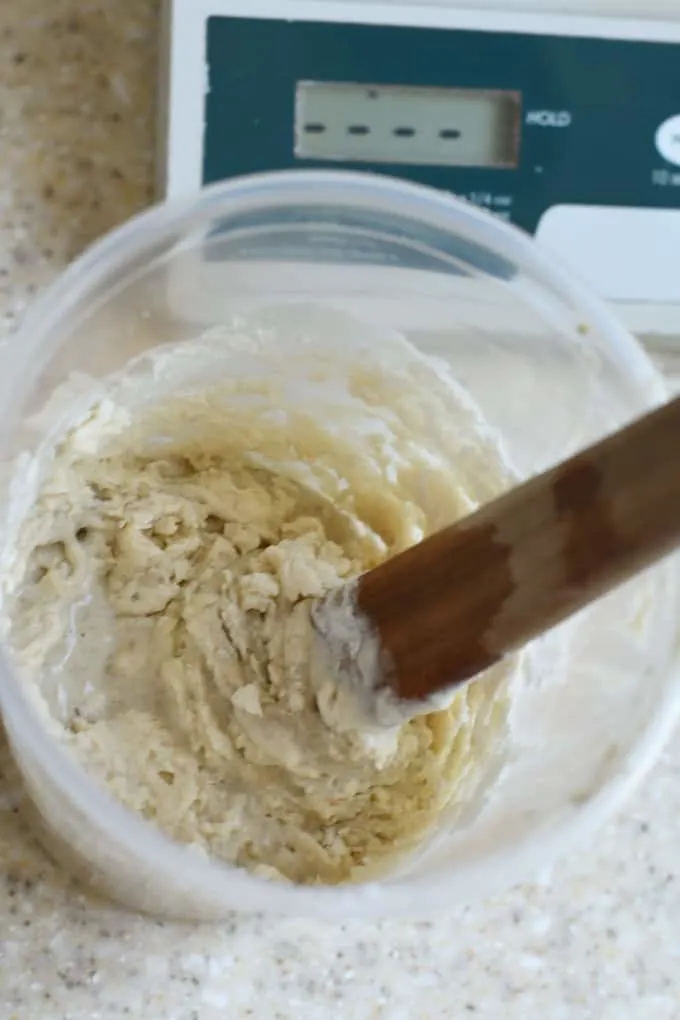
Right off the bat I’m going to say that there are a million ways to feed, maintain and use a sourdough starter. In fact, after you’re done reading this post, you should read through my instructions for How to keep a small sourdough starter to see of that method would work better for you.
I am going to outline for you how I maintain my sourdough starters. I tend to have a fairly relaxed attitude towards the process. It works for me and I think my approach can work for you if you don’t bake bread every single day (and even if you do).
At the end of the post you’ll find a how-to card that lists the ingredient amounts and steps to follow each time you feed your starter.
But first I’m going to give you all the how’s and why’s and try to answer any questions you might have.
Tips for using and maintaining your sourdough starter:
- Since I don’t bake every day, I keep my starters (yes, I have 3) in the refrigerator.
- If I’m making a 2-day recipe (most of mine are) I take the starter out of the refrigerator early in the morning of the day I’m making the dough. If the starter is inactive I feed it right away and it should be ready by early afternoon.
- If I’m making a 1-day recipe, I’ll take the starter out the night before and feed it if it’s inactive. It should be ready to use first thing in the morning.
- When the starter is cold from the refrigerator, I feed the starter using fairly warm water, warmer than body temp. The warm water will jump-start the cold starter.
- If the starter has been fed within the last 2-3 days, and has been refrigerated, you can probably go ahead and use it without feeding.
- If you’re not sure if the starter is active, drop a dollop into a bowl of water to see if it floats. If it does, it’s ready for baking.
- I write all my sourdough recipes to use 8 oz of active starter. After using 8 oz of starter in the recipe, I’m left with 4 oz of starter, exactly the right amount for feeding.
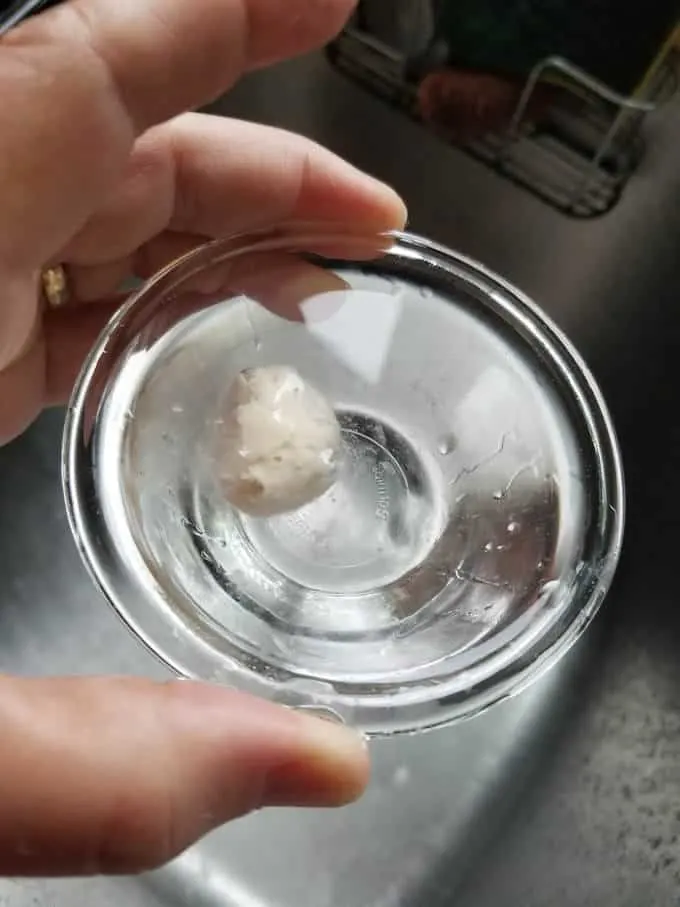
Schedule for feeding your sourdough starter:
- Your starter needs to be fed about 1x per week if refrigerated, and every day if left at room temperature.
- Generally, about 5-6 hours after feeding my starter is ready. The time may vary based on room temp, dough temp, etc. The starter should have doubled in volume and started to recede and/or pass the float test.
- I take my starter out of the refrigerator once a week for feeding, even if I’m not baking. Although, truth be told, I often go longer than a week between feedings and I haven’t killed it yet.
- Did you know you can dry your sourdough starter? Dried starter can be kept indefinitely.
- After you’ve removed the portion of starter for baking, feed the starter again and leave it at room temperature for 3-4 hours before putting it back in the refrigerator.
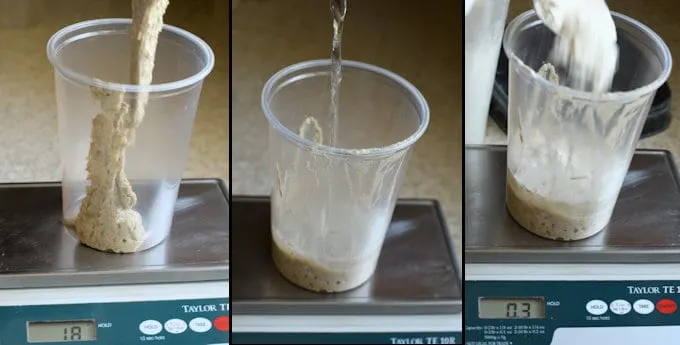
FAQs about feeding & maintaining Sourdough Starter:
Honestly, I’ve gone longer than a month without feeding my starter and I haven’t killed it yet. Give it a feeding and see if it wakes up. If it’s alive, keep feeding it until it is reliably doubling in size within 4-5 hours.
If you go more than about 2 weeks between feedings, you might want to give the starter 2-3 feedings before using. A starter that hasn’t been fed for weeks will be quite sluggish and your dough won’t be as lively.
If your starter was fed a day or two before, it’s possible to use the starter straight from the refrigerator. Give it a float test to make sure it’s active. The dough may take a little longer to ferment since the temperature of the dough will be colder.
It’s called “hooch” and don’t worry, your starter is still alive. Just stir that water back into the starter before feeding. Again, you might need 2 feedings to completely revive the starter since it’s been quite dormant.
To maintain your starter at 100% hydration it is best and most accurate to weigh your ingredients. If you’re just a little bit off every time you feed, eventually, your starter could be thrown out of balance.
No problem, use the amount of starter called for in the recipe. Then weigh out 4 oz of the remaining starter for feeding and discard the rest.
If you continually feed the starter without discarding, you’ll end up drowning in starter.
Yes, even if the discard is not active enough for baking bread, you can add it to many other recipes as a flavor and texture enhancer.
Unless you’re going away for an extended time, your starter should be just fine for a couple of weeks in the refrigerator. If you’ll be gone really long-term, put the starter into the freezer or dry it. Frozen or dried starter will need several feedings to rejuvenate.
If you appreciate this detailed information, I’d really appreciate a 5-star review.
How to Feed Sourdough Starter
Ingredients
- 4 oz unfed sourdough starter
- 4 oz all purpose flour
- 4 oz water (room temperature)
Instructions
- Weigh 4 oz of your unfed starter into a clean container. Discard the extra starter (see note)4 oz unfed sourdough starter
- Add the flour and water and mix until combined. Set aside at room temperature.4 oz all purpose flour, 4 oz water
- The starter is ready to use when it has doubled in volume and a small spoonful floats when dropped into a bowl of water. This generally takes 4-5 hours but the time can vary based on dough temperature and room temperature.
- If you do not plan to bake with the starter on the day it is fed, refrigerate 3-4 hours after feeding.
- Feed refrigerated starter weekly. If you go longer than a week without feeding, you may want to give the starter two feedings before using.
Would you like to save this recipe?
As an Amazon Associate and member of other affiliate programs, I earn from qualifying purchases.

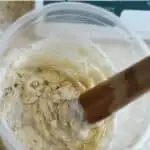





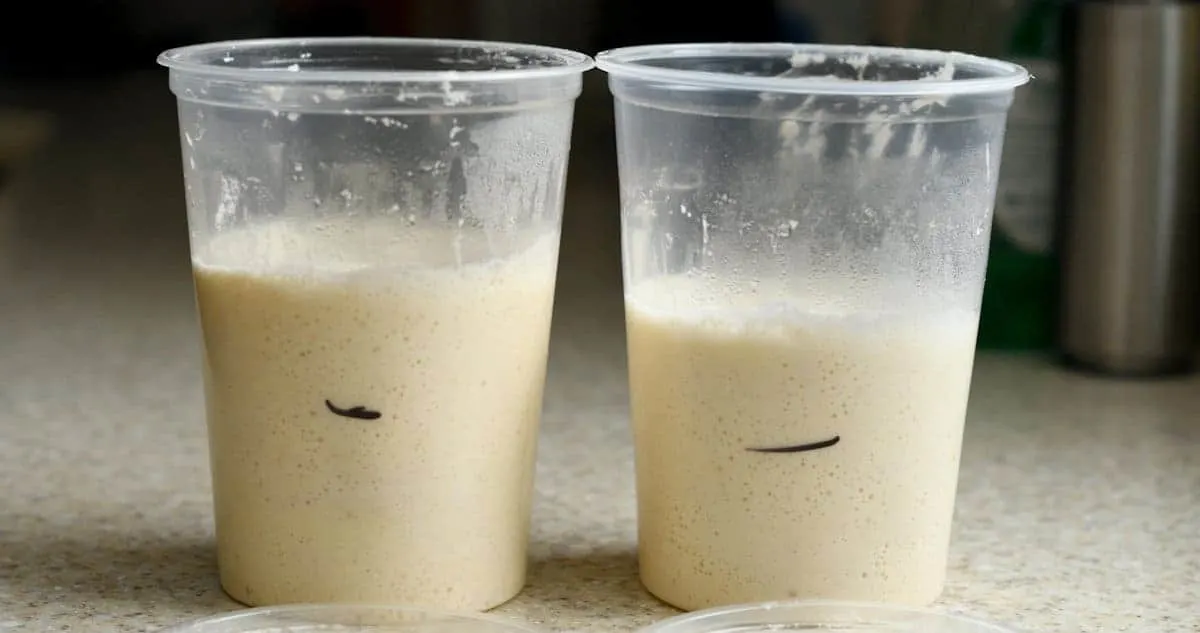
Can I feed the starter with bread flour? I was kindly given some sourdough starter from anItalian restaurant and I don’t want toess it up! I only have bread flour but I could buy other flour if needed. Thanks!
You can use bread flour. Bread flour will absorb more water than ap flour so your starter will be a little thicker than one fed with ap flour.
@Eileen Gray, Thank you!
My starter is 9 months old and I keep it in the refrigerator.
I feed it once a week. Do I still have to use distilled water and whole wheat flour to keep it going? Or could I use tapwater and regular flour?
I always use tap water and regular flour. Unless your tap water is super chlorinated and it is good drinking water you should be able to use it to feed your starter. I generally use King Arthurs unbleached AP flour for feeding. Occasionally, if I’m making whole wheat or rye bread, I’ll feed with the whole grain flour.
Feeding sourdough just taken from fridge do I feed let prove 6/8 hours & then return to fridge or just feed & put straight back in fridge.?z
I usually feed it and give it a couple of hours at room temperature. Usually 2-3 hours is enough time. I like to see that it’s active and growing before it goes back into the fridge.
Thank you so very much for your excellent and very helpful information on keeping a sourdough starter ‘baby’alive!!
I have recently begun this new hobby (or obsession-as my husband has righly observed).
My friend who gave me starter- and continues to when something goes awry-happens to be the person you described as “drowning in starter”. Now I willnot only be following your instructions, but also intend to pass your info on to her. I now have a renewed hope in my success as a sourdough ‘Mama’!
Thank the Lord! And my husband thanks you too!
Ha, ha. Have your friend read How to Keep A Small Starter. Only 3 oz of starter and very little discard.
my starter will now pass float test several hours after feeding. But right out of the refrigerator it never does becuase it has fallen. In your directions you state that you can use starter right out of the fridge if it is still active. I always feed it first, but do i have to. Am I doing something wrong if it falls in the regrigerator?
No, it will rise and fall in the refrigerator. It goes through the same cycle, just a little slower than it would at room temperature. I find that if I feed my starter and refrigerate it after 2-3 hours it is active enough to bake with for a couple of days. After about 2-3 days I will feed it before baking. It’s not an exact science and each starter will behave differently for a myriad of reasons.